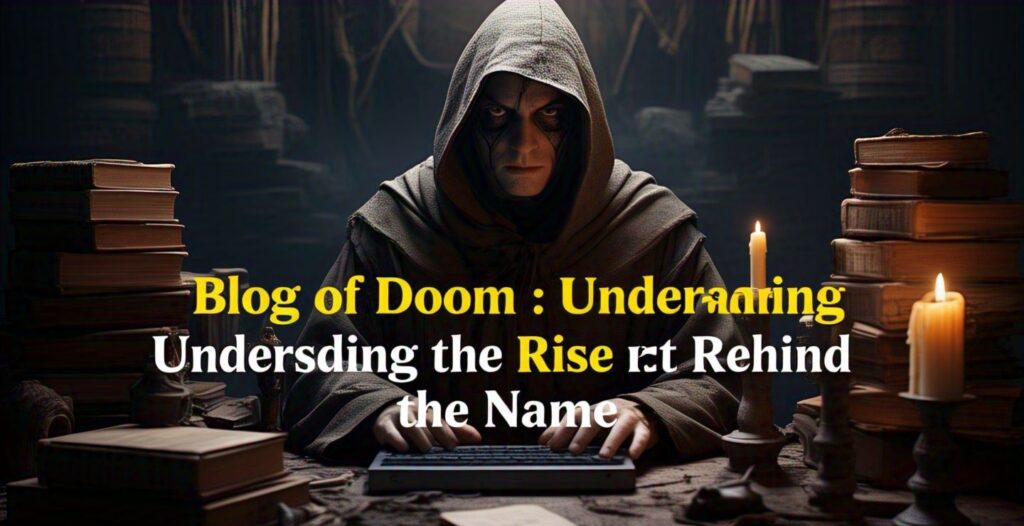
Introduction
The term “blog of doom“ might sound dramatic, but it reflects a powerful corner of the internet. These blogs often focus on dark, dystopian, or apocalyptic topics. From climate change to economic collapse, they provide a platform for discussing worst-case scenarios and the future of humanity in a rapidly changing world.
What Is a Blog of Doom?
A blog of doom typically covers global crises, environmental destruction, societal collapse, or political instability. These blogs don’t aim to spread fear but instead raise awareness. They highlight ignored or suppressed issues, pushing readers to reflect deeply on current problems and imagine potential outcomes we may face soon.
History of Doom Blogging
Doom blogs gained popularity in the early 2000s as blogging platforms like Blogger and WordPress emerged. Many people, especially academics, survivalists, and activists, started using them to discuss critical events such as the 2008 financial crash or rising global temperatures. These blogs served as a wake-up call for many readers.
Common Topics in a Blog of Doom
Climate Change and Environmental Collapse
Many doom blogs emphasize climate issues—melting ice caps, rising temperatures, ocean acidification, and species extinction. Writers often back up claims with scientific data. Their goal is to alert readers to the urgency of the climate crisis and encourage actions that might mitigate irreversible environmental damage.
Economic Downfall and Collapse Theories
Another hot topic is the fragility of global economies. A blog of doom might explore debt crises, inflation, cryptocurrency volatility, or food shortages. These blogs often provide analysis of economic models, historical data, and current policies to argue that collapse might be nearer than we think.
Political Unrest and Global Conflicts
Doom bloggers also focus on civil wars, international tensions, and government surveillance. By tracking news across multiple nations, they reveal patterns of instability that mainstream media often downplays. These posts aim to prepare readers—mentally and practically—for possible societal disruptions or authoritarian developments.
Why Do People Read Blogs of Doom?
Despite their grim content, doom blogs attract loyal audiences. People read them to stay informed, prepare for disasters, or confirm their suspicions about global trends. They offer a sense of community where readers can share knowledge, ideas, and survival strategies in a world that often seems chaotic and uncertain.
The Psychological Effects of Doom Blogging
Fear and Anxiety
Consuming too much doom content can lead to stress or eco-anxiety. When readers are constantly exposed to negative news, they may feel overwhelmed or helpless. Doom blogs can amplify these feelings if they focus solely on catastrophe without offering solutions or hope.
Awareness and Empowerment
However, many blogs of doom also aim to empower readers. They provide educational resources, action plans, and strategies to deal with future problems. For some, reading these blogs is a form of preparation, helping them feel more in control and less surprised by unfolding events.
Who Writes the Blog of Doom?
Most doom bloggers are not professional journalists. They may be scientists, economists, teachers, or concerned citizens with a deep understanding of their subject. They often use verified data and cite credible sources. Their passion lies in helping others see the truth and prepare wisely.
Doom Blogging vs. Misinformation
Facts vs. Fear
Not all doom blogs are created equal. Some spread baseless theories or use fear to gain clicks. A credible blog of doom distinguishes itself by relying on research, peer-reviewed studies, and expert interviews. It balances caution with logic, helping readers separate hype from hard reality.
Responsible Reading
Readers must evaluate blogs critically. Look for citations, data, and balanced viewpoints. A responsible doom blog doesn’t just shout warnings—it also encourages readers to think critically and engage with solutions. Misinformation can do more harm than good, especially in times of crisis.
How to Start Your Own Blog of Doom
If you’re passionate about global issues and want to start a blog of doom, begin by picking your focus—environment, economics, politics, or survivalism. Choose a blogging platform and create valuable, informative content. Use keywords, research thoroughly, and build credibility by staying consistent and fact-driven.
SEO Tips for Doom Bloggers
Keyword Integration
To attract traffic, integrate keywords like “blog of doom,” “collapse news,” or “economic crisis updates” naturally into your content. Avoid keyword stuffing. Focus on helpful titles, meta descriptions, and well-structured posts that keep users reading and sharing.
Use of Visuals and Data
Charts, graphs, and images make complex topics easier to understand. A successful doom blog includes data visualizations to support claims. Infographics on population growth, resource depletion, or economic trends help readers digest heavy content and increase your blog’s authority.
The Future of Doom Blogging
As crises evolve, so will doom blogs. With AI, data analysis, and citizen journalism growing, blogs will become more informative and interactive. We may see multimedia doom platforms, integrating videos, podcasts, and real-time alerts for global risks—transforming the traditional blog of doom into an all-encompassing knowledge hub.
Positive Sides of the Blog of Doom
Awareness and Change
Despite their dark tone, doom blogs often spark action. From supporting eco-initiatives to lobbying for economic reform, readers often leave more informed and motivated. These blogs show us what could happen—but also what we can still prevent if we act in time.
Building Prepared Communities
A blog of doom can inspire individuals to connect, prepare, and collaborate. Online forums, prepper groups, and activist movements often form around these blogs. People share tools, resources, and ideas, creating communities that thrive on preparation and resilience, not just fear.
Conclusion
The blog of doom serves as both a mirror and a warning bell. It reflects the current state of the world—raw, real, and sometimes terrifying. But it also helps people wake up, take notice, and prepare. While doom blogging can be intense, it holds immense value in today’s uncertain times.
